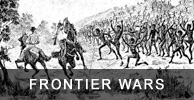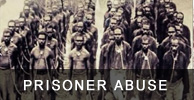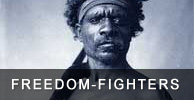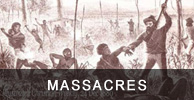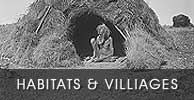'Conspiracy Of Silence' - Blood baths of the past by Dr. Timothy Bottoms


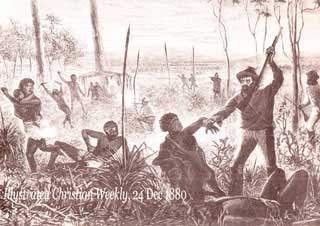
(Image: Illustrated Christian Weekly 24 Dec 1880)
Denise Carter The Cairns Post 17 March 17 2012
When driving between Woree and Edmonton over Skeleton Creek in Far North Queensland, a vision of skulls on posts is not likely to be conjured in your mind.
Although it might, had you read local author Dr Timothy Bottoms' book, Conspiracy of Silence, about the massacres of Aborigines on Queensland's 19th century frontier.
"There were 16 skulls on posts," Dr Bottoms says from his Edge Hill home.
The skulls were just part of the results of what Bottoms calls The Skull Pocket, Mulgrave River, Skeleton Creek battle (or blood bath), which he says was the stuff of nightmares.
European settlers, both with and without the Queensland Native Mounted Police, "dispersed" gatherings of Aborigines, which involved shooting men, women and children.
The native mounted police were trained and equipped by the colonial government under the helm of a sub inspector, ultimately accountable to the Queensland Colonial Secretary.
They were Aboriginal men usually living and recruited miles away from where they were to operate, Dr Bottoms says, so they had no allegiance to the people they were required to kill.
"There were death squads on the frontier," he says.
The Skeleton Creek battte started north of Yungaburra.
It was commented upon by Jack Kane from Yungaburra, who was 18 when he was a participant in 1884, in an interview with Dr Norman Tindale recorded in Tindale's expedition diary in 1938.
Kane said: "I didn't mind the killing of the bucks but I didn't quite like them braining the kids."
"The babies were bashed against trees until their brains splattered out," Dr Bottoms says.
Dr Bottoms created the foundations for the book while researching A History of Cairns, a Cairns Regional Council commissioned work, which was, controversially, not published in 2003.
"I was trying to paint the Sistine Chapel in words but they wanted a roller block job on a toilet block," Bottoms says.
At the time the council cited the cost of publication as the reason.
Dr Bottoms says Queensland Museum are currently considering his book for publication this year, and as the basis for a six-month exhibition in 2013.
For Conspiracy of Silence, which a Queensland Museum spokeswoman described as "a very substantial research work", he used primary source documents and spoke to both indigenous and non-indigenous Australians, starting his work with the arrival of Captain Cook from the point of view of the rainforest Aboriginal people.
He says he debunks "the pioneering myth" that Australia was settled in a peaceful manner.
Dr Bottoms explains the pioneering myth does not mention (or briefly mentions) the impact on indigenous Australians and places emphasis on white man's achievements in conquering the land.
During his research and writing, he mapped where massacres occurred.
He says the difference between his work and that of others is locating the massacres.
"I have identified each on a map so you can follow them and the result is astounding," he says.
At the outset, Bottoms believed the massacres may have just happened in the Cairns area.
"When I stood back, I had to pick my jaw up from the floor," he says."I had no idea.
"Now I believe what I've uncovered is less than 10 per cent of the massacres in Queensland."
The book includes a map of the massacres all over Queensland.
Based on historian Professor Raymond Evans' figures, Bottoms says the amount of men, women and children killed in such massacres stands at about 50,000 between 1859 and 1897.
Any protests from the white population, he says, were quashed with social and economic restrictions, and so protestors usually used nom de plumes to vent their angst in newspapers.
There were, nevertheless, people who did speak out against the atrocities to no avail.
"Their valiant efforts were ignored by successive governments," Dr Bottoms says.
Other massacres included the Massacre of the Mitchell River (or The Battle of Mitchell River) and the Speewah Massacre.
"You can map the genealogies for clan groups and there are big gaps," Dr Bottoms says.
Dr Bottoms worked with indigenous elder Ernie Grant of the Jirrbal/Girramay people in Tully when researching his book and plans to work with him in the future.
"We are looking at doing a documentary film in the style of Two Men In A Tinnie," Dr Bottoms says.
"I would be travelling with Ernie through the frontier."
The idea would be to stop off at points of interest and analyse past events.
Dr Bottoms has been spreading the word about the massacres around the country.
He presented at the Q150 conference in Brisbane and his presentation is available online.
And while presenting at the National Museum of Australia, where he was awarded a fellowship as writer in residence, Dr Bottoms says he received a standing ovation.
The researching and writing has come at a personal cost.
Apart from the effort involved in such a vast amount of work, he says he found his discoveries very depressing.
"I found it horrific," he says.
"Most of my crying I did while reading about it 20 years ago.
"It doesn't help your wellbeing."
But it has been worthwhile.
"I passionately believe it had to be done," he says.
Dr Bottoms believes this largely unnoticed history of Australia has to be acknowledged.
"We can't as a nation walk on an international stage if we don't clean our backyard."
This is an important, well researched book: challenging, compelling and controversial. It is a must read for anyone interested in Australian history. - Henry Reynolds
As Europeans moved into new lands in Queensland in the 19th century, violent encounters with local Aboriginals mostly followed. Drawing on extensive original research, Timothy Bottoms tells the story of the most violent frontier in Australian colonial history.
The Queensland frontier was more violent than any other Australian colony. From the first penal settlement at Moreton Bay in 1824, as white pastoralists moved into new parts of country, violence invariably followed. Tens of thousands of Aboriginals were killed on the Queensland frontier alone. Europeans were killed too, but in much smaller numbers.
The cover up began from the start: the authorities in Sydney and Brisbane didn't want to know, the Native Police did their deadly work without hindrance, and the pastoralists had every reason to keep it to themselves. Even today, what we know about the killing times is swept aside again and again in favour of the pioneer myth.
The Conspiracy of Silence is the first systematic account of frontier violence in Queensland. Following in the tracks of the pastoralists as they moved into new lands across the state in the 19th century, Timothy Bottoms identifies massacres, poisonings and other incidents, including many that no-one has documented in print before. He explores the colonial mindset and explains how the brutal dispossession of Aboriginal landowners continued over decades.
... a road-map back into what seems, from a modern perspective, to be a barely conceivable past. From the foreword by Raymond Evans
Timothy Bottoms is a Cairns-based historian and author. His previous books are 'Djabugay Country' and 'A History of Cairns'. He is an Historical consultant & Educator, Expertise in regional & frontier Australian history. - tim@timothybottoms.com

